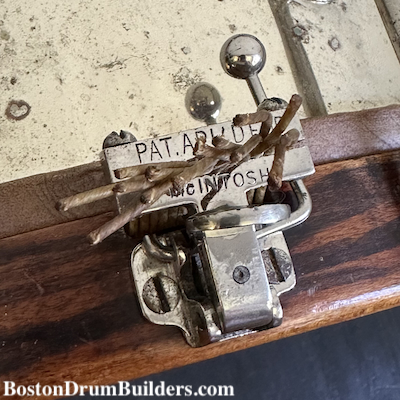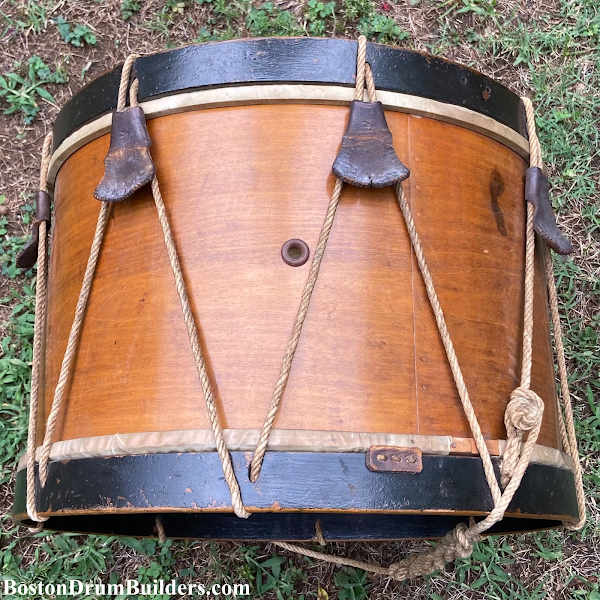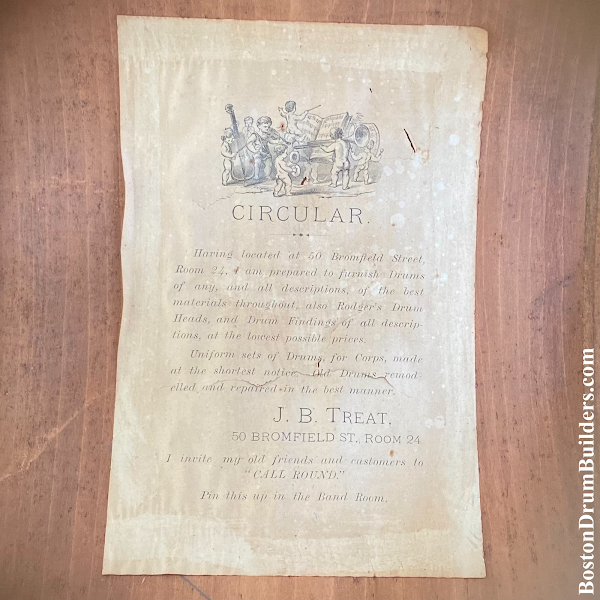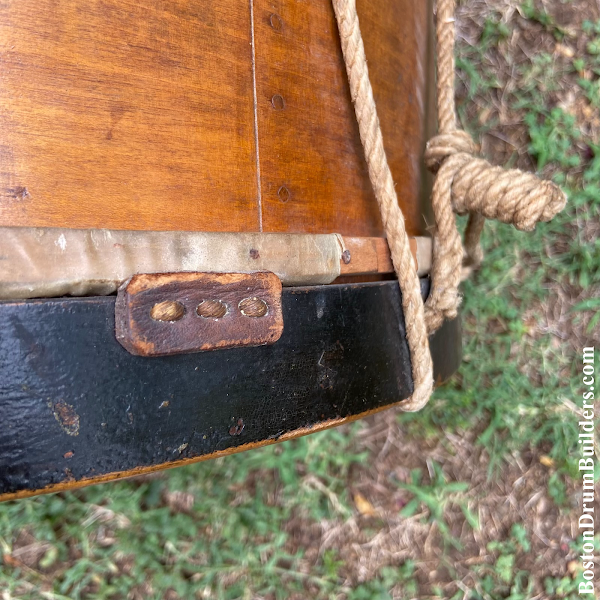Boston's
John C. Haynes & Company dealt a wide variety of musical instruments including many that were imported or sourced from other makers. Drum building, however, was a central element of their business from the outset. Haynes advertising from the early 1860s commonly promotes their "Massachusetts Drum Manufactory". Makers labels found inside early Haynes drums mirror this wording.
Haynes produced a huge quantity of drums during the second half of the 19th century, a majority of which were rope tension drums built around natural colored maple shells with black painted wooden counterhoops - a motif favored by band instrument makers in and around Boston during the later decades of the 1800s. By contrast, drums from the earliest days of Haynes production are typically stained a dark brown color with matching counterhoops. Less common are drums with ornately painted eagle motifs or artwork denoting a particular regiment.
It is a common misconception that any Haynes drum with a label bearing the address of 33 Court Street dates from the Civil War. While the company was indeed located at this address during the Civil War era, Haynes continued to do business at 33 Court Street until the early 1890s. The drum featured here is presumed to have been produced in 1862 and is typical of Haynes' early period.
Acquired from a great, great grandson of the original owner, the drum remained in the family for more than 150 years, its provenance having mostly been lost. No signature or name is anywhere to be found. Aside from a well-preserved makers label, the sole visible markings are the letter "e" and a number "5" written boldly in black ink inside the shell. Only after a good amount of research into military records and family genealogy would the drum begin to reveal its backstory reconnecting it with very specific time and place, and to the soldier who once carried it.
Ezra Morse was born January 3rd, 1835 in Ashland, Massachusetts where he would spend most of his adult life. On September 27, 1855, he was married to Ellen Lucinda Dadmun, a native of Framingham. Marriage records list Morse's occupation as "farmer". 1860 Census records show Ezra and Ellen with two young children living in the Dadmun household while Ezra worked as a carpenter. The couple would eventually bear six children. On August 28, 1862 Morse enlisted in the Fifth Regiment of the Massachusetts Volunteer Infantry mustering into service on September 16th. He was discharged at Boston on July 2nd, 1863.
Copious documentation exists on the Fifth Regiment's movements and activities during the Civil War thanks in part to a 1911 publication by the Fifth Regiment Veteran Association. "THE FIFTH REGIMENT MASSACHUSETTS VOLUNTEER INFANTRY IN ITS THREE TOURS OF DUTY 1861, 1862-'63, 1864"
by Alfred S. Roe offers several mentions of Morse including a first-hand account of him having been part of the regimental band. This along with other military records identifies Morse as a member of Company E from the Fifth Regiment. This explains the "5" and "e" marked inside of the shell and presumably dates Morse's drum as having been manufactured no later than 1863.
Following the War, Ezra Morse had a long and successful career as an auctioneer and trader dealing in commodities such as coal, lumber, and wool. He also maintained an active involvement in the Grand Army of the Republic, a fraternal organization formed by veterans of the Union forces. Morse was among the forty charter members of Massachusetts' Colonel Prescott Post 18 upon its founding in August of 1867 and later served as Commander (1882) and Adjutant (1910).
The Ashland Historical Society has extensive records pertaining to the history of GAR Post 18 including a "Personal War Sketch" signed by Morse. This document brings to light many fascinating details including the names of Morse's "most intimate comrades" during his time in service and chronicles his participation in the march from New Bern to Goldsboro, and battles at Kinston and Whitehall, North Carolina.
Also in the holdings of the Society is a brass horn attributed to Morse which raises the intriguing possibility that he played multiple instruments or perhaps was not a drummer at all. It could be that one instrument, either the drum or the horn, was his own while the other was kept as a relic. The Ashland Band, which appears to have been closely aligned with Post 18, likely made use of whatever instruments they could find including those leftover from the War. And considering Morse's involvement in the Fifth Regiment, the GAR, and the Ashland Band, instrument sharing seems highly plausible.
Around the late 1870s, Ezra Morse served for three years as Deputy Sheriff - one of the few tangible pieces of information which had remained with the drum. Morse passed away on November 21st, 1919, outliving his wife by nearly two decades. Following his death, the Morse drum ended up in the possession of Ezra's eldest son, Charles E. Morse (b. 1870 - d. 1941). The drum was acquired from his descendants in the Spring 2022.
W. Lee Vinson is a classical percussionist, music educator, and snare drum historian. He is the author of BostonDrumBuilders.com, a website devoted to the late 19th and early 20th century drum makers of Boston, Massachusetts.




























